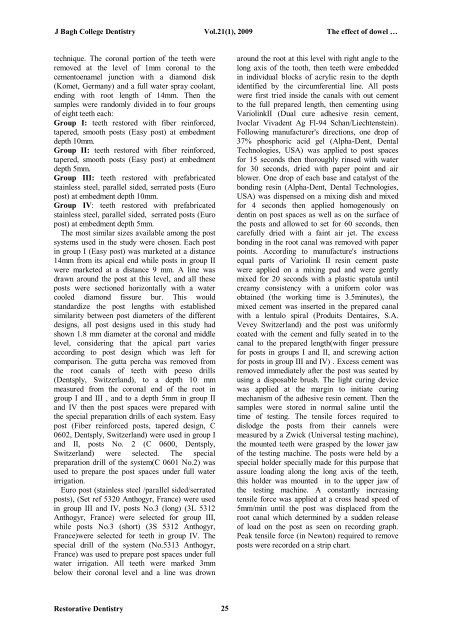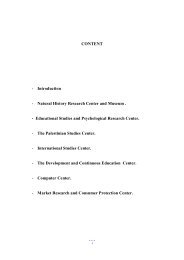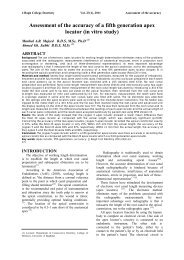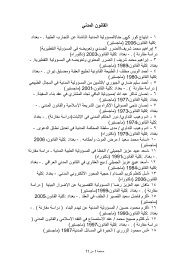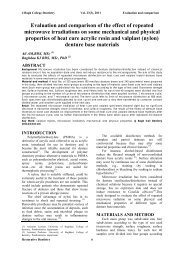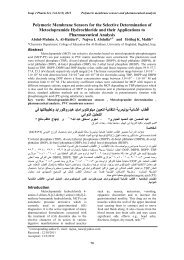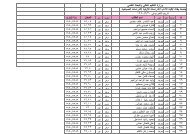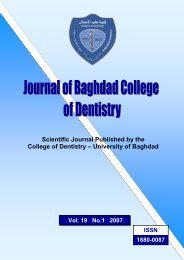Vol 21 No. 1
Vol 21 No. 1
Vol 21 No. 1
Create successful ePaper yourself
Turn your PDF publications into a flip-book with our unique Google optimized e-Paper software.
J Bagh College Dentistry <strong>Vol</strong>.<strong>21</strong>(1), 2009 The effect of dowel …<br />
technique. The coronal portion of the teeth were<br />
removed at the level of 1mm coronal to the<br />
cementoenamel junction with a diamond disk<br />
(Komet, Germany) and a full water spray coolant,<br />
ending with root length of 14mm. Then the<br />
samples were randomly divided in to four groups<br />
of eight teeth each:<br />
Group Ι: teeth restored with fiber reinforced,<br />
tapered, smooth posts (Easy post) at embedment<br />
depth 10mm.<br />
Group ΙΙ: teeth restored with fiber reinforced,<br />
tapered, smooth posts (Easy post) at embedment<br />
depth 5mm.<br />
Group ΙΙΙ: teeth restored with prefabricated<br />
stainless steel, parallel sided, serrated posts (Euro<br />
post) at embedment depth 10mm.<br />
Group ΙV: teeth restored with prefabricated<br />
stainless steel, parallel sided, serrated posts (Euro<br />
post) at embedment depth 5mm.<br />
The most similar sizes available among the post<br />
systems used in the study were chosen. Each post<br />
in group Ι (Easy post) was marketed at a distance<br />
14mm from its apical end while posts in group ΙΙ<br />
were marketed at a distance 9 mm. A line was<br />
drawn around the post at this level, and all these<br />
posts were sectioned horizontally with a water<br />
cooled diamond fissure bur. This would<br />
standardize the post lengths with established<br />
similarity between post diameters of the different<br />
designs, all post designs used in this study had<br />
shown 1.8 mm diameter at the coronal and middle<br />
level, considering that the apical part varies<br />
according to post design which was left for<br />
comparison. The gutta percha was removed from<br />
the root canals of teeth with peeso drills<br />
(Dentsply, Switzerland), to a depth 10 mm<br />
measured from the coronal end of the root in<br />
group Ι and ΙΙΙ , and to a depth 5mm in group ΙΙ<br />
and ΙV then the post spaces were prepared with<br />
the special preparation drills of each system. Easy<br />
post (Fiber reinforced posts, tapered design, C<br />
0602, Dentsply, Switzerland) were used in group Ι<br />
and ΙΙ, posts <strong>No</strong>. 2 (C 0600, Dentsply,<br />
Switzerland) were selected. The special<br />
preparation drill of the system(C 0601 <strong>No</strong>.2) was<br />
used to prepare the post spaces under full water<br />
irrigation.<br />
Euro post (stainless steel /parallel sided/serrated<br />
posts), (Set ref 5320 Anthogyr, France) were used<br />
in group ΙΙΙ and ΙV, posts <strong>No</strong>.3 (long) (3L 5312<br />
Anthogyr, France) were selected for group ΙΙΙ,<br />
while posts <strong>No</strong>.3 (short) (3S 5312 Anthogyr,<br />
France)were selected for teeth in group ΙV. The<br />
special drill of the system (<strong>No</strong>.5313 Anthogyr,<br />
France) was used to prepare post spaces under full<br />
water irrigation. All teeth were marked 3mm<br />
below their coronal level and a line was drown<br />
around the root at this level with right angle to the<br />
long axis of the tooth, then teeth were embedded<br />
in individual blocks of acrylic resin to the depth<br />
identified by the circumferential line. All posts<br />
were first tried inside the canals with out cement<br />
to the full prepared length, then cementing using<br />
VariolinkΙΙ (Dual cure adhesive resin cement,<br />
Ivoclar Vivadent Ag Fl-94 Schan/Liechtenstein).<br />
Following manufacturer's directions, one drop of<br />
37% phosphoric acid gel (Alpha-Dent, Dental<br />
Technologies, USA) was applied to post spaces<br />
for 15 seconds then thoroughly rinsed with water<br />
for 30 seconds, dried with paper point and air<br />
blower. One drop of each base and catalyst of the<br />
bonding resin (Alpha-Dent, Dental Technologies,<br />
USA) was dispensed on a mixing dish and mixed<br />
for 4 seconds then applied homogenously on<br />
dentin on post spaces as well as on the surface of<br />
the posts and allowed to set for 60 seconds, then<br />
carefully dried with a faint air jet. The excess<br />
bonding in the root canal was removed with paper<br />
points. According to manufacture's instructions<br />
equal parts of Variolink ΙΙ resin cement paste<br />
were applied on a mixing pad and were gently<br />
mixed for 20 seconds with a plastic spatula until<br />
creamy consistency with a uniform color was<br />
obtained (the working time is 3.5minutes), the<br />
mixed cement was inserted in the prepared canal<br />
with a lentulo spiral (Produits Dentaires, S.A.<br />
Vevey Switzerland) and the post was uniformly<br />
coated with the cement and fully seated in to the<br />
canal to the prepared length(with finger pressure<br />
for posts in groups Ι and ΙΙ, and screwing action<br />
for posts in group ΙΙΙ and ΙV) . Excess cement was<br />
removed immediately after the post was seated by<br />
using a disposable brush. The light curing device<br />
was applied at the margin to initiate curing<br />
mechanism of the adhesive resin cement. Then the<br />
samples were stored in normal saline until the<br />
time of testing. The tensile forces required to<br />
dislodge the posts from their cannels were<br />
measured by a Zwick (Universal testing machine),<br />
the mounted teeth were grasped by the lower jaw<br />
of the testing machine. The posts were held by a<br />
special holder specially made for this purpose that<br />
assure loading along the long axis of the teeth,<br />
this holder was mounted in to the upper jaw of<br />
the testing machine. A constantly increasing<br />
tensile force was applied at a cross head speed of<br />
5mm/min until the post was displaced from the<br />
root canal which determined by a sudden release<br />
of load on the post as seen on recording graph.<br />
Peak tensile force (in Newton) required to remove<br />
posts were recorded on a strip chart.<br />
Restorative Dentistry<br />
25


